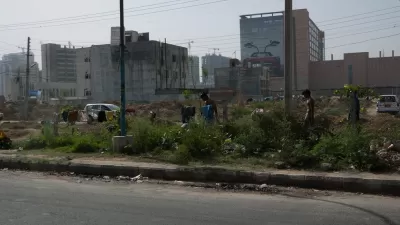The mega cities of the developing world are expected to experience increasing rates of growth in the coming decades. The growth in population will be a challenge, but so will be dealing with the increase in air pollution.
"According to the World Resources Institute (WRI), urban populations in the developing world are growing at 3.5 percent per year, compared to less than 1 percent growth rates in developed world cities."
"UN-Habitat says that a staggering 95 percent of the expected global population growth we will see over the next 2 decades will be absorbed by cities in the developing world."
"What that means is by 2030 another 2 billion people from the developing world will be living in cities (only 100 million from the developed world meanwhile will be doing the same). Currently 75 percent of world's poorest people -- 1 billion -- live in cities."
"When it comes to poor cities, bigger is by no means always better. According to UN Habitat, the mega-cities of the future, (those with more than 10 million residents) will be "giant potential flood and disaster traps" if insufficient action is taken on behalf of their residents."
"Already, 75 percent of the world's 21 mega-cities are based in the developing world, and by some estimates, 27 of the 33 mega-cities expected to exist by 2015 will be in developing countries."
"Rapid economic growth brings substantial problems of its own -- notably increased pollution. Already, 16 of the 20 most polluted cities in the world are in China, which is arguably undergoing the most rapid industrial and economic transformation the world has ever seen."
FULL STORY: All About: Developing cities and pollution

Maui's Vacation Rental Debate Turns Ugly
Verbal attacks, misinformation campaigns and fistfights plague a high-stakes debate to convert thousands of vacation rentals into long-term housing.

Planetizen Federal Action Tracker
A weekly monitor of how Trump’s orders and actions are impacting planners and planning in America.

In Urban Planning, AI Prompting Could be the New Design Thinking
Creativity has long been key to great urban design. What if we see AI as our new creative partner?

Cal Fire Chatbot Fails to Answer Basic Questions
An AI chatbot designed to provide information about wildfires can’t answer questions about evacuation orders, among other problems.

What Happens if Trump Kills Section 8?
The Trump admin aims to slash federal rental aid by nearly half and shift distribution to states. Experts warn this could spike homelessness and destabilize communities nationwide.

Sean Duffy Targets Rainbow Crosswalks in Road Safety Efforts
Despite evidence that colorful crosswalks actually improve intersection safety — and the lack of almost any crosswalks at all on the nation’s most dangerous arterial roads — U.S. Transportation Secretary Duffy is calling on states to remove them.
Urban Design for Planners 1: Software Tools
This six-course series explores essential urban design concepts using open source software and equips planners with the tools they need to participate fully in the urban design process.
Planning for Universal Design
Learn the tools for implementing Universal Design in planning regulations.
Appalachian Highlands Housing Partners
Gallatin County Department of Planning & Community Development
Heyer Gruel & Associates PA
Mpact (founded as Rail~Volution)
City of Camden Redevelopment Agency
City of Astoria
City of Portland
City of Laramie



























